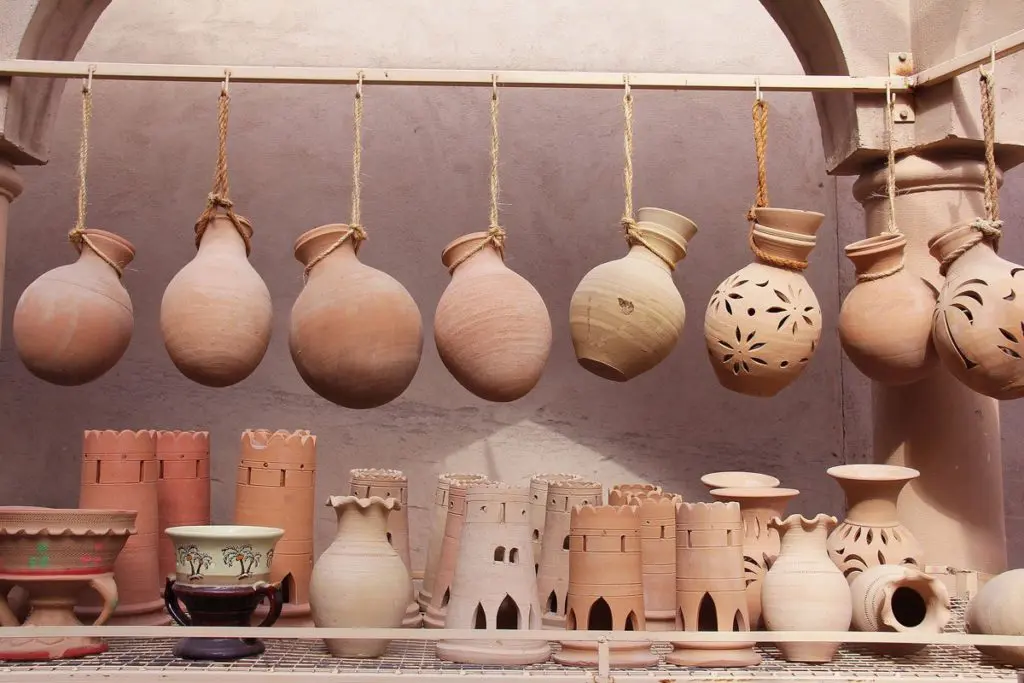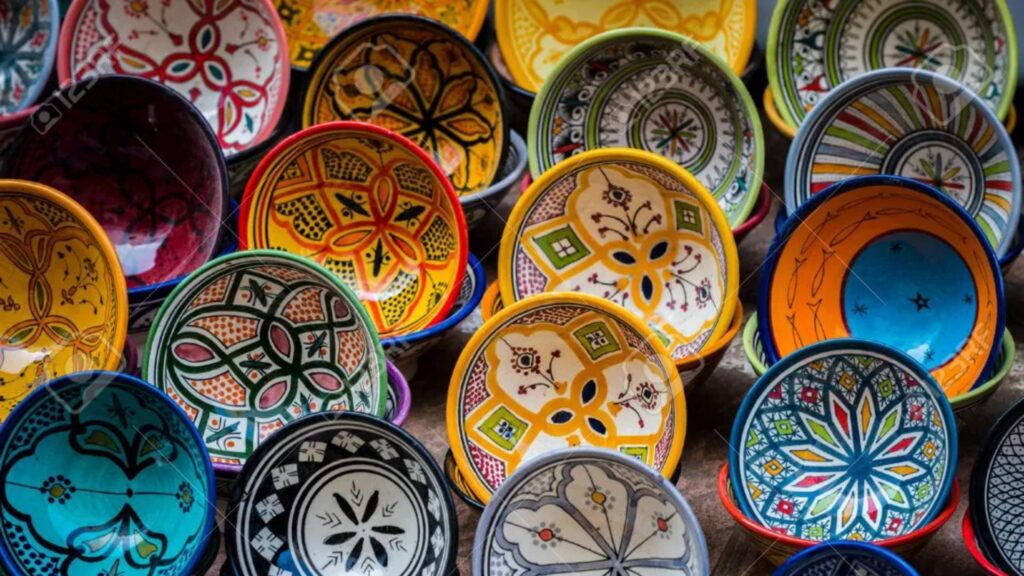Table of Contents
Moroccan Pottery: Discover the Beauty, History & Styles of Morocco
Discover the Soul of Morocco Through Its Pottery
Have you ever held a piece of pottery that felt like it had a story to tell? Moroccan pottery is more than just clay shaped by hand. It’s a living tradition, passed down through generations, a tactile narrative of culture, craftsmanship, and identity. When you explore pottery in Morocco, you’re not just shopping for bowls or serving dishes—you’re engaging with an art form that continues to evolve while staying deeply rooted in history.
The History of Moroccan Pottery: A Legacy Carved in Clay
Your journey with Moroccan pottery begins in the sands of time. This tradition stretches back over a thousand years, drawing from Berber, Arab, Andalusian, and sub-Saharan African influences. The story of Morocco’s ceramics is intertwined with the rise and fall of empires—from the Almoravid to the Marinid dynasty.
As you walk through a market in Fes or Safi, know that each piece reflects centuries of trial, error, and innovation. Safi Morocco pottery, in particular, became internationally recognized for its vibrant glazes and utilitarian forms, while Fes pottery is known for its classic blue-and-white designs, rooted in Islamic geometry and symbolism.
Regional Styles and Techniques in Moroccan Pottery

Each region in Morocco brings its own flavor to pottery creation, and you can spot the differences with a bit of practice.
Fes Pottery: Blue and White Elegance
- Cobalt blue on white clay
- Influenced by zellige (tilework) and Islamic art
- Often used in Moroccan serving dishes and decor
Safi Pottery: The Art of Glazing
- Bright, multi-colored glazes
- Popular for both export and local use
- Intricate patterns using molds and hand-carving
Tamegroute Pottery: Mystical Green Clay
- Earthy green glaze made with secret, ancient recipes
- Asymmetrical, rustic feel
- Often used in Moroccan cooking pottery like tagines
| Region | Color Palette | Common Products | Special Features |
|---|---|---|---|
| Fes | Blue & White | Bowls, tiles, serving dishes | Fine geometric detail |
| Safi | Multicolor | Decorative vases, tableware | High-quality glaze |
| Tamegroute | Deep green | Tagines, candle holders | Traditional kilns, rustic form |
The Process of Making Moroccan Pottery
If you’re curious about how this ancient craft comes to life, here’s a step-by-step view into the creation of Moroccan ceramics.
From Earth to Art: Step-by-Step
- Clay sourcing: Natural clay is collected from Moroccan soil.
- Kneading and shaping: Artisans use traditional foot-powered wheels or hand-molding techniques.
- Drying: Pieces are dried in the sun for days.
- Carving and decorating: Designs are carved or painted.
- First firing: Initial kiln firing solidifies the form.
- Glazing: A colorful or clear glaze is applied.
- Second firing: This seals and finishes the pottery.
Tools and Materials Used
- Hand-carved wooden tools
- Natural pigments from minerals and plants
- Traditional kilns often fueled by wood or olive pits
Each step demands patience, precision, and deep respect for tradition. The result is not just a ceramic item, but a timeless expression of Moroccan culture.
Symbolism and Meaning in Moroccan Pottery Designs
What makes Moroccan pottery truly captivating is not just its form, but its symbolism. When you examine a Moroccan bowl or plate, you’re seeing layers of meaning:
Geometric and Floral Motifs
- Represent unity, eternity, and balance
- Common in Fes pottery and Moroccan ceramics
Arabic Calligraphy and Symbols
- Invokes blessings, protection, or philosophical concepts
Color Psychology
- Blue: Spiritual protection, often seen in Fes pottery
- Green: Life and fertility, signature of Tamegroute
- Red: Power, passion, and courage, used in Safi designs
Understanding these symbols adds a new layer of appreciation when selecting Moroccan serving dishes or antique Moroccan pottery for your home.
Moroccan Pottery in Everyday Life
Moroccan pottery isn’t just beautiful—it’s also functional. Here’s how it shows up in daily Moroccan life and how you can bring it into yours.
In Moroccan Homes
- Tagines: Used for slow cooking rich, flavorful meals
- Bowls and plates: Serve couscous, tagines, and mezze
- Pitchers: Often used for serving mint tea or water
In Celebrations and Rituals
- Wedding gifts: Ornate sets given to brides
- Religious feasts: Pottery used to serve special dishes
In Your Modern Decor
- Use a pottery barn Moroccan pouf beside your handcrafted tagine for a perfect blend of old-world charm and modern comfort
- Hang Moroccan ceramics on a kitchen wall as functional art
What to Look For
- Handcrafted imperfections (no two are alike)
- Signature stamps or etched initials
- Natural, unprocessed clay bases
Avoid mass-produced pieces that may mimic the look but lack the cultural significance.
How to Care for Moroccan Pottery
Once you own a beautiful piece of Moroccan pottery, you’ll want to keep it looking its best.
- Cleaning: Use mild soap and warm water. Avoid dishwashers.
- Storage: Don’t stack heavy items on fragile pieces.
- Seasoning: Unglazed tagines should be soaked in water and slowly heated before first use.
- Temperature shock: Always bring pottery to room temp before placing on heat.
FAQs About Moroccan Pottery
What makes Moroccan pottery unique?
It’s a blend of historical influences, artistic symbolism, and functional design that you won’t find in any other region.
Is Moroccan pottery food-safe?
Most modern pieces are. For vintage or antique Moroccan pottery, double-check for lead-free glaze.
Can Moroccan pottery be used on stovetops?
Yes, especially unglazed cooking tagines, but always use a heat diffuser.
Where can I learn more about Moroccan ceramics?
Try visiting workshops in Fes or Safi. Some online courses also offer beginner-level tutorials.
Conclusion: The Living Art of Moroccan Pottery
You’ve now traveled through the clay-rich landscapes of Morocco without leaving your seat. From Fes pottery to the rustic greens of Tamegroute, every piece you encounter tells a story that began centuries ago.
Bringing Moroccan ceramics into your life is more than decorating—it’s about connecting with a rich artistic tradition that values detail, patience, and meaning.
Ready to Own a Piece of Morocco?
Explore local markets, support fair trade artisans, or start your own collection of Moroccan bowls, tagines, and serving dishes. Let every meal, every cup of tea, and every decorative touch reflect the soul of Moroccan craftsmanship.

